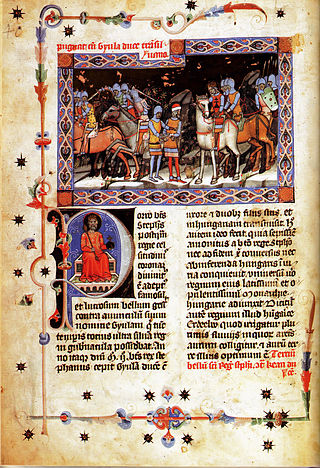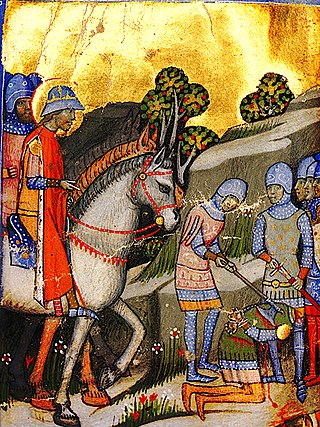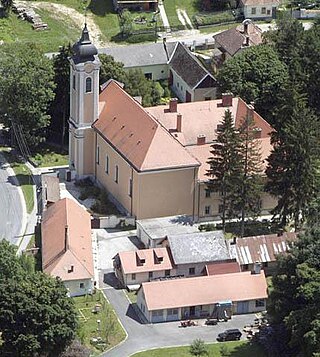
Géza, also Gejza, was Grand Prince of the Hungarians from the early 970s. He was the son of Grand Prince Taksony and his Oriental—Khazar, Pecheneg or Volga Bulgarian—wife. He married Sarolt, a daughter of an Eastern Orthodox Hungarian chieftain. After ascending the throne, Géza made peace with the Holy Roman Empire. Within Hungary, he consolidated his authority with extreme cruelty, according to the unanimous narration of nearly contemporaneous sources. He was the first Hungarian monarch to support Christian missionaries from Western Europe. Although he was baptised, his Christian faith remained shallow and he continued to perform acts of pagan worship. He was succeeded by his son Stephen, who was crowned the first King of Hungary in 1000 or 1001.

Stephen I, also known as King Saint Stephen, was the last Grand Prince of the Hungarians between 997 and 1000 or 1001, and the first King of Hungary from 1000 or 1001, until his death in 1038. The year of his birth is uncertain, but many details of his life suggest that he was born in, or after, 975, in Esztergom. He was given the pagan name Vajk at birth, but the date of his baptism is unknown. He was the only son of Grand Prince Géza and his wife, Sarolt, who was descended from a prominent family of gyulas. Although both of his parents were baptized, Stephen was the first member of his family to become a devout Christian. He married Gisela of Bavaria, a scion of the imperial Ottonian dynasty.

Taksony was the Grand Prince of the Hungarians after their catastrophic defeat in the 955 Battle of Lechfeld. In his youth he had participated in plundering raids in Western Europe, but during his reign the Hungarians only targeted the Byzantine Empire. The Gesta Hungarorum recounts that significant Muslim and Pecheneg groups settled in Hungary under Taksony.

Zoltán, also Zolta, Zsolt, Solt or Zaltas is mentioned in the Gesta Hungarorum as the third Grand Prince of the Hungarians who succeeded his father Árpád around 907. Although modern historians tend to deny this report on his reign, because other chronicles do not list him among the Hungarian rulers, there is consensus that even if Zoltán never ascended the throne, all monarchs ruling in Hungary from the House of Árpád after around 955 were descended from him.

Vazul, or Vászoly, was a member of the House of Árpád, a grandson of Taksony, Grand Prince of the Hungarians. The only other certain information about his life is that he was kept in captivity and blinded in the fortress of Nyitra in the last years of the reign of his cousin, King Stephen I of Hungary. Modern historians, including György Györffy, do not exclude that he had earlier been Duke of Nyitra. He is the forefather of nearly all Kings of Hungary who reigned after 1046.

Arad County was an administrative unit in the Kingdom of Hungary, the Eastern Hungarian Kingdom and the Principality of Transylvania. The county was established along the Maros (Mureș) river in the 11th or the 12th century, but its first head, or ispán, was only mentioned in 1214. Its territory is now part of Romania, except a small area which is part of Hungary. The capital of the county was Arad.

Gesta Hungarorum, or The Deeds of the Hungarians, is the earliest book about Hungarian history which has survived for posterity. Its genre is not chronicle, but gesta, meaning "deeds" or "acts", which is a medieval entertaining literature. It was written in Latin by an unidentified author who has traditionally been called Anonymus in scholarly works. According to most historians, the work was completed between around 1200 and 1230. The Gesta exists in a sole manuscript from the second part of the 13th century, which was for centuries held in Vienna. It is part of the collection of Széchényi National Library in Budapest.
Menumorut or Menumorout was the ruler of the lands between the rivers Mureș, Someș and Tisza at the time of the Hungarian conquest of the Carpathian Basin around 900, according to the Gesta Hungarorum, a Hungarian chronicle written after 1150 by an unidentified author, referred to as Anonymus. Historians debate whether Menumorut was an actual ruler or a fictional character created by the author, since the Gesta tells of multiple figures, including Menumorut, who are not identified in any other primary sources, and does not name any of the enemies of the invading Hungarians written of in other contemporary accounts of the invasion. According to Anonymus, Menumorut's duchy was populated primarily with Khazars and Székelys, and he acknowledged the suzerainty of the (unnamed) ruling Byzantine Emperor at the time.

Gyula was, according to Muslim and Byzantine sources, the title of one of the leaders, the second in rank, of the Hungarian tribal federation in the 9th–10th centuries. In the earliest Hungarian sources, the title name is only recorded as a personal name.

Ajtony, Ahtum or Achtum was an early-11th-century ruler in the territory now known as Banat in present Romania and Serbia. His primary source is the Long Life of Saint Gerard, a 14th-century hagiography. Ajtony was a powerful ruler who owned many horses, cattle and sheep and was baptised according to the Orthodox rite in Vidin. He taxed salt which was transferred to King Stephen I of Hungary on the Mureș River. The king sent Csanád, Ajtony's former commander-in-chief, against him at the head of a large army. Csanád defeated and killed Ajtony, occupying his realm. In the territory, at least one county and a Roman Catholic diocese were established.

Samuel Aba reigned as King of Hungary between 1041 and 1044. He was born to a prominent family with extensive domains in the region of the Mátra Hills. Based on reports in the Gesta Hungarorum and other Hungarian chronicles about the non-Hungarian origin of the Aba family, modern historians write that the Abas headed the Kabar tribes that seceded from the Khazar Khaganate and joined the Hungarians in the 9th century.
Levente was a member of the House of Árpád, a great-grandson of Taksony, Grand Prince of the Hungarians. He was expelled from Hungary in 1031 or 1032, and spent many years in Bohemia, Poland and the Kievan Rus'. He returned to Hungary, where a pagan uprising was developing around that time, in 1046. Levente remained a devout pagan, but did not hinder the election of his Christian brother, Andrew I as king.

Koppány, also called Cupan was a Hungarian lord in the late 10th century and leader of pagans opposing the Christianization of Hungary. As the duke of Somogy, he laid claim to the throne based on the traditional idea of seniority, but was defeated and executed by Stephen, son of the previous grand prince Géza.
Gyula III, also Iula or Gyula the Younger, Geula or Gyla, was an early medieval ruler in Transylvania. Around 1003, he and his family were attacked, dispossessed and captured by King Stephen I of Hungary (1000/1001-1038). The name "Gyula" was also a title, the second highest rank in Hungarian tribal confederation.

Michael was a member of the House of Árpád, a younger son of Taksony, Grand Prince of the Hungarians. Most details of his life are uncertain. Almost all kings of Hungary after 1046 descended from him.

The Pécsvárad Abbey was a Benedictine monastery established at Pécsvárad in the Kingdom of Hungary in the first decades of the 11th century. Its patrons were the Virgin Mary and Saint Benedict of Nursia.

The Bakonybél Abbey is a Benedictine monastery established at Bakonybél in the Kingdom of Hungary in the first decades of the 11th century. Its patron is Saint Maurice.
Otto (Atha) from the kindred Győr was a Hungarian noble in the second half of the 11h century, who served as palatine in 1066, during the reign of Solomon, King of Hungary. He was the ancestor of the gens Győr, which flourished until the 17th century.
Dózsa Debreceni, or Dózsa of Debrecen, was an influential lord in the Kingdom of Hungary in the early 14th century. He was Palatine in 1322, and Voivode of Transylvania between 1318 and 1321. He was one of the staunchest supporters of Charles I of Hungary.

The Dömös Chapter was a collegiate chapter, established around 1107, in the Kingdom of Hungary. It was dedicated to Saint Margaret of Antioch.











